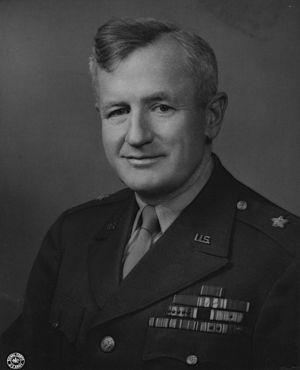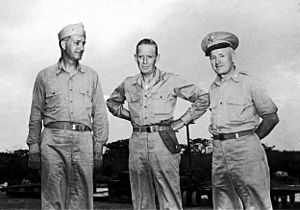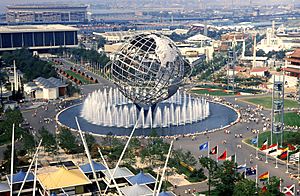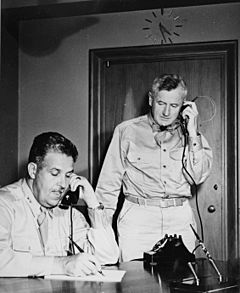Thomas Farrell (general) facts for kids
Quick facts for kids
Thomas Farrell
|
|
|---|---|

Brigadier General Thomas F. Farrell
|
|
| Birth name | Thomas Francis Farrell |
| Born | 3 December 1891 Brunswick, New York |
| Died | 11 April 1967 (aged 75) Reno, Nevada |
| Allegiance | |
| Service/ |
United States Army |
| Years of service | 1916–1946 1950–1952 |
| Rank | |
| Service number | 0-227201 |
| Battles/wars | World War I:
|
| Awards | Distinguished Service Cross Army Distinguished Service Medal Legion of Merit (2) Purple Heart Croix de guerre (France) |
| Relations | Barbara Vucanovich (daughter) Patricia Dillon Cafferata (granddaughter) Peter Farrell (great-grandson) |
Thomas Francis Farrell (born December 3, 1891 – died April 11, 1967) was an important American Army officer. He was the second-in-command for the Manhattan Project, which was a secret effort to build the first atomic bombs during World War II. He worked closely with Major General Leslie R. Groves, Jr..
Farrell studied civil engineering and graduated in 1912. During World War I, he served as an engineer on the Western Front in France. He received several awards for his bravery, including the Distinguished Service Cross. After the war, he taught at military schools. He later worked for the State of New York, helping to build canals and other public works.
When World War II began, Farrell returned to the Army. He helped build important roads in the China-Burma-India area. In 1945, he became the second-in-command of the Manhattan Project. He saw the first atomic bomb test, called the Trinity test. He also helped supervise the bombings of Hiroshima and Nagasaki in Japan. After the war, he led teams to study the effects of the atomic bombs.
After his military career, Farrell worked on housing projects in New York City. He also advised the United Nations Atomic Energy Commission and helped with the 1964 New York World's Fair.
Contents
Early Life and Military Service
Thomas Francis Farrell was born on December 3, 1891, in Brunswick, New York. He was one of nine children in his family. His family lived on a large farm where they grew apples and raised animals. All the children helped with farm work.
Farrell graduated from Rensselaer Polytechnic Institute in 1912 with a degree in civil engineering. His first job was working on the New York State Barge Canal. He then worked on the famous Panama Canal from 1913 to 1916.
World War I Hero
In 1916, Farrell joined the Army Corps of Engineers. He married Maria Ynez White in 1917 before going to France with the American Expeditionary Force. He joined the 1st Engineers. He quickly rose through the ranks, becoming a major by 1918.
Farrell fought in several major battles during World War I, including the Battle of Cantigny and the Meuse-Argonne Offensive. His unit's main job was to build and fix roads and bridges. However, during the Argonne battle, Farrell's group had to fight like infantry soldiers. For his brave leadership, he received the Distinguished Service Cross.
His award citation praised his "extraordinary heroism." It said he led his battalion to capture and hold a key hill, even though they were greatly outnumbered. His courage inspired his soldiers. He also received the French Croix de guerre. After the war, he joined the regular Army and taught at military schools until 1926.
Public Works in New York
In 1926, Farrell left the regular Army but stayed in the reserves. The Governor of New York, Al Smith, appointed him as the Commissioner of Canals and Waterway for New York State. From 1930 to 1941, he led construction and engineering for the New York State Department of Public Works.
During the Great Depression, there was a lot of public works activity. Farrell helped with big projects in New York, including the 1939 New York World's Fair and the building of LaGuardia Airport.
World War II Service
In February 1941, Farrell returned to active duty in the Army. He worked with Leslie R. Groves, Jr. in the Construction Division. This division was responsible for building military camps and training facilities for the growing US Army. Farrell and Groves created new, simpler ways to manage these huge construction projects. Farrell received the Legion of Merit for his work.
Building in China-Burma-India
In 1943, Farrell was sent to the China-Burma-India theater to oversee construction. His main task was to help build a supply route from India to China. This was one of the biggest engineering challenges of the war.
Farrell was promoted to brigadier general in January 1944. He was in charge of construction inside India, while Colonel Lewis A. Pick managed the Ledo Road itself. Farrell also had to support Operation Matterhorn, which involved building and expanding air bases for B-29 bombers. He had to make tough decisions, like changing the route of an oil pipeline to avoid dangerous areas. For his important work, he received the Distinguished Service Medal.
The Manhattan Project
In December 1944, Henry L. Stimson, the Secretary of War, asked Groves to find a deputy for the Manhattan Project. Groves chose Farrell, saying he was his first choice. Farrell learned about the physics of the atomic bomb from J. Robert Oppenheimer.
Farrell visited the Alamogordo Bombing and Gunnery Range, where the Trinity test would take place. He later said that when he held a piece of plutonium, he felt its "hidden power" and began to believe the scientists' "fantastic tales" about nuclear energy.
Farrell watched the Trinity test with Oppenheimer. He described the explosion as "unprecedented, magnificent, beautiful, stupendous, and terrifying." He wrote that "No man-made phenomenon of such tremendous power had ever occurred before." He felt that "Words are inadequate tools for the job of acquainting those not present with the physical, mental and psychological effects. It had to be witnessed to be realized."

Farrell was responsible for the combat operations of the atomic bombs. In July 1945, he went to Guam to coordinate with local commanders. He, Rear Admiral William R. Purnell, and Captain William S. Parsons became known as the "Tinian Joint Chiefs." They made important decisions about the nuclear missions.
Farrell informed Groves that the Little Boy bomb would be ready around August 3. After a few B-29 crashes, Parsons suggested arming the bomb in flight for safety. Farrell agreed. After the bombing of Hiroshima on August 6, Farrell debriefed the aircrews and sent a detailed report to Groves.
Farrell moved up the date for the next attack because of good weather predictions. He even signed the Fat Man bomb, "To Hirohito, with love and kisses, T. F. Farrell." Despite some fuel pump issues, the mission to Nagasaki was successful.
After Japan surrendered on August 14, Farrell prepared teams to inspect the damage in Hiroshima and Nagasaki. He arrived in Hiroshima on September 8 with a group of scientists. They were amazed by the destruction caused by the atomic bombs.
After the War

Farrell was promoted to major general in October 1945. He remained Deputy Commander of the Manhattan Project until he retired from active service in April 1946. He then became chairman of the New York City Housing Authority. He worked to provide public housing, especially for returning soldiers. He believed that people of different races could live together peacefully in these projects.
He also advised the United Nations Atomic Energy Commission. In 1950, during the Korean War, Farrell returned to the Army again. He worked for the Atomic Energy Commission (AEC), which took over from the Manhattan Project. He greatly increased the AEC's ability to produce nuclear weapons.
Farrell left the AEC and the Army again in February 1952. He then worked as a consultant on large construction projects, like the Cross Bronx Expressway. From 1960 to 1964, he helped prepare for the 1964 New York World's Fair.
Farrell had five children: Thomas, Barbara, Peter, Patricia, and Stephen. His son Thomas was killed in action during World War II. His daughter, Barbara Vucanovich, became the first woman from Nevada to be elected to the United States House of Representatives. His granddaughter, Patricia Dillon Cafferata, served as Nevada State Treasurer.
Thomas Farrell died in Reno, Nevada, on April 11, 1967. He was remembered for his lifetime of building things, but also for his role in the atomic bombings of Hiroshima and Nagasaki.
Images for kids






